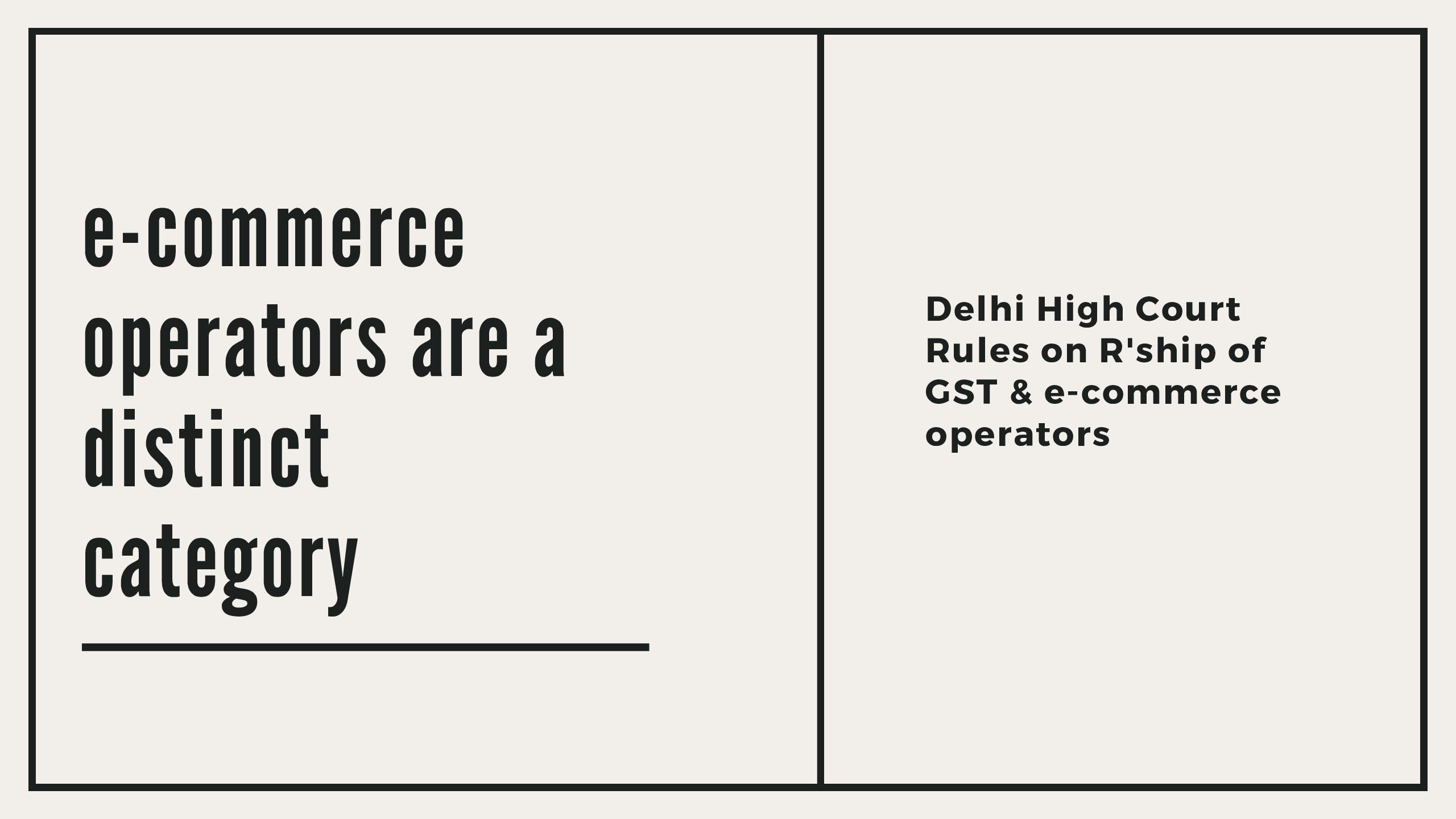This is the second of a two-part post on the Supreme Court’s judgment in Union of India v Mohit Minerals[1] pronounced on 19 May 2022. In the first part, I focused on the Supreme Court’s observations on legal value of the GST Council’s recommendations. In this post, I will focus on the statutory aspects of the case: the arguments, the Supreme Court’s engagement with the same and the basis of its conclusion that IGST on ocean freight was not permissible.
To briefly recall, the dispute centred around two Notifications issued by the Union. Notification 8/2017 provided IGST shall be levied on supply of services, i.e., transportation of goods in a vessel from a place outside India up to the customs clearance in India under a CIF contract. And an IGST of 5% was levied supply of such services. Notification 10/2017, issued under Section 5(3) categorised the recipient of such services to include the importer based in India with IGST payable under reverse charge.
Statutory Provisions and Relevant Arguments
At the outset, it is worth citing is Section 5(1) of IGST Act, 2017 which states that:
Subject to the provisions of sub-section (2), there shall be levied a tax called the integrated goods and services tax on all inter-State supplies of goods or services or both, except on the supply of alcoholic liquor for human consumption, on the value determined under section 15 of Central Goods and Services Act and at such rates, not exceeding forty per cent., as may be notified by the Government on the recommendations of the Council and collected in such manner as may be prescribed and shall be paid by the taxable person:
And, Section 5(3), IGST Act, 2017 which states that:
The Government may, on the recommendations of the Council, by notification, specify categories of supply of goods or services or both, the tax on which shall be paid on reverse charge basis by the recipient of such goods or services or both and all the provisions of this Act shall apply to such recipient as if he is the person liable for paying the tax in relation to the supply of such goods or services or both.
The assessee argued that Section 5(3) only delegates the power to identify the categories of goods or services on which tax shall be paid on reverse charge basis and not identify a recipient of supply. Notification 10/2017, on the other hand, identified the importer as a recipient for purposes of Section 5(3) and was ultra vires the IGST Act on the ground of excessive delegation. The Supreme Court rejected this argument and stated that the essential legislative functions had been performed by the legislature. It referred to Section 5(1), IGST Act, 2017 and Section 2(107), CGST Act, 2017 to conclude that levy of tax, subject matter of tax, value for purpose of taxation and taxable person had been provided in these respective provisions. Crucially, it referred to the definition of ‘recipient’ under Section 2(93) of CGST Act, 2017 which includes a person to whom possession or use of goods is made available. The importer of goods was included in this category.
The Supreme Court concluded that the Union had in exercise of powers under Section 5(3) only specified the categories of supply and the stipulation that the importer was the recipient of supply of transportation services was only clarificatory. In other words, the Notification did not traverse beyond the statute in identifying the recipient and could not be said to suffer from the vice of excessive delegation.
Regarding Section 5(1), IGST Act, 2017, the assessee argued that it is a charging provision and Sections 5(3) and Section 5(4) cannot be used to create an independent charge. The Supreme Court opined that Section 5(1) identifies the four canons of taxation: taxable event, taxable person, taxable rate, and taxable value. And that Section 5(3) and 5(4) are inextricably linked to the charging provision Section 5(1) as the charging and machinery provisions need to be understood as an integrated code. The Court then referred to Rule 31, CGST Rules, 2017 under which value of supply can be determined for cases not specifically mentioned in other rules, and concluded that neither of the two Notifications could be struck down on the ground of excessive delegation as they had correctly identified the taxable person and prescribed the IGST rate. The Supreme Court upheld the power to determine the tax rate through a Notification since the basic framework had been provided by the Parliament under the aforementioned provisions.
The Supreme Court’s engagement with assessee’s argument on Section 5(1) is confusing. It engages with the assessee’s argument about excessive delegation, inter-relationship of the various sub-sections of section 5, IGST Act, 2017 in an overlapping manner without sufficiently clarifying either aspect. The relevant paragraphs of the judgment have an awkward logical flow and the reasoning on this point is uneven. And while the conclusion on the above mentioned points are correct, the reasoning lacks pinpointed analysis and is impeded by reference to numerous statutory provisions that are not relevant to the issues.
Another crucial question that the Supreme Court had to engage with was: if imported goods on a CIF basis constituted an inter-State supply? The Supreme Court referred to Section 7, CGST Act, 2017 which inter alia defines supply to include ‘import of services for a consideration whether or not in the course or furtherance of business;’. It also referred to Section 7(4), IGST Act, 2017 which defines an inter-State supply to include supply of services imported into the territory of India. Referring to the above provisions, the Supreme Court noted that an Indian importer could be considered as importer of service of shipping liable to IGST if the activity falls within the definition of ‘import of service’. Accordingly, it then examined the definition of import of service.
Section 2(11), CGST Act, 2017 states that import of services means the supply of any service, where –
- The supplier is located outside India;
- The recipient of service is located in India; and
- The place of supply of service is in India;
The assessee’s argument was that conditions (ii) and (iii) were not satisfied in the impugned case. The assessee was relying on the contract between the foreign exporter and the foreign shipping service based outside India. But the Supreme Court stated that the answer must be found in statutory provisions and not in terms of the contract. In pursuance of the same, it referred to Section 13(9), IGST Act, 2017 which provides that place of supply of services where location of supplier or location of recipient is outside India shall in case of service of transportation of goods shall be place of destination of such goods. Relying on Section 13(9), IGST Act, 2017 the Supreme Court held that since the goods under the CIF contract would enter the Indian taxable territory, place of supply of shipping service would be India. Thus, condition (iii) was held to be fulfilled in the impugned case.
The thorny question was proving that the recipient of service was located in India to fulfil condition (ii). This could only be true if the importer was identified as the recipient of shipping services. The Supreme Court did not accept the State’s argument it had powers to designate any person to pay tax on a reverse charge basis irrespective of their status as a recipient. Neither did it accept that any person identified for payment of reverse charge would automatically become the recipient. On both counts the Supreme Court was right. However, the Supreme Court still concluded that the importer was a recipient by relying on the definition of recipient under Section 2(93)(c), CGST Act, 2017 which inter alia stated that ‘any reference to a person to whom a supply is made shall be construed as reference to the recipient of the supply’. Reading Section 2(93)(c), CGST Act, 2017 with Section 13(9), IGST Act, 2017 stated above, it concluded that:
In such a scenario, when the place of supply of services is deemed to be the destination of goods under Section 13(9) of the IGST Act, the supply of services would necessarily be “made” to the Indian importer, who would then be considered as a “recipient” under the definition of Section 2(93)(c) of the CGST Act. The supply can thus be construed as being “made” to the Indian importer who becomes the recipient under Section 2(93)(c) of the CGST Act. (para 118)
By interpreting the definition of recipient in conjunction with place of supply, the Supreme Court relied on a deeming fiction to remove a major obstacle in the State’s way. In contractual terms, the recipient in a CIF basis would ordinarily be the exporter since the consideration flows from the exporter to the shipping company. But, the Supreme Court’s insistence on understanding the terms by referring to the statutory provisions instead of relying on commercial parlance proved fruitful for the State. (para 102) The Supreme Court’s approach also negatived the assessee’s challenge that levy was extra-territorial in nature since the transaction took place outside India. This is because as per the Supreme Court the destination of goods was India and services were ‘rendered for the benefit of the Indian importer.’ (para 108) Though the Supreme Court did not address the issues of extra-territoriality and identification of recipient in the same chronological fashion.
IGST on Ocean Freight Runs into the Hurdle of Double Taxation
The State’s case fell on the benign hurdle of double taxation. It is important to first state that a composite supply means a supply made by a taxable person to a recipient consisting of two or more taxable supplies of goods or services or both which are naturally bundled together and supplied in conjunction with each other in the ordinary course of business. Section 8, CGST Act, 2017 states that a composite supply comprising of two or more supplies one of which is a principal supply, shall be treated as supply of such principal supply. The deeming fiction under Section 8 of CGST Act, 2017 being that two supplies would be treated as a single supply and would be subject to the tax rate of the principal supply.
In the impugned case, for the first leg of the transaction between the foreign exporter and Indian importer, latter was liable to pay IGST on value goods, but the valuation included the cost of shipping services, i.e., cost of insurance and freight as the said transaction was treated as a composite supply. Thus, IGST was levied on supply of goods, since it was the principal supply in accordance with Section 8, CGST Act, 2017.
The State argued that the second leg of the transaction between the foreign exporter and the shipping line should be treated as an independent contract operating in silos. The Supreme Court did not accept this argument reasoning that the State had argued that both legs of the transaction are connected when it argued that the importer was the recipient, but to tide over the composite supply provisions it is making a contradictory argument that the transactions are standalone. The State justified its contradictory stance by relying on the aspect theory wherein different aspects of a transaction can be subjected to different taxes. For instance, in the impugned case, the State could levy GST on the supply of imported goods as well as supply of transportation services, since they were different aspects of the same transaction.
While the Supreme Court accepted that different aspects of a transaction can be taxed under the aspect theory, but it emphasised that in such a case value of goods cannot be included in services and vice-versa. While the State in the impugned case had included the value of services when levying IGST on supply of goods by invoking the concept of composite supply. The Supreme Court rightly concluded that supply of service of transportation by the foreign shipper forms a part of the bundle of supplies between the foreign exporter and Indian importer on which IGST is payable. To levy IGST on supply of service component of the transaction would contradict the principle under Section 8, CGST Act, 2017 and be in violation of the scheme of the GST legislation.
Conclusion
The Supreme Court in the impugned decision waxes eloquent on the nature and structure of GST and various parts of the judgment are informative and well-reasoned. At the same time, various provisions of CGST Act, 2017 and IGST Act, 2017 are cited that are not germane to the issue. The judgment though well-structured on first glance, struggles in identifying priority issues and its various parts seem superfluous and not necessary to adjudicate the central issue. While these might sound like lesser evils given some other judgments of the Supreme Court that lack basic reasoning, they are still worth mentioning. Overall, the judgment did arrive at the right conclusion, and endorsed a well-reasoned judgment of the Gujarat High Court which was under appeal in this case. Despite the State losing this case, there are several takeaways for it, one prominent one is that the net of extra-territorial taxation has been cast wide and beyond with the Supreme Court’s observations. If an Indian resident is the ultimate recipient of a transaction occurring outside India, the State can extend its GST jurisdiction on such an overseas transaction in various circumstances. It would be surprising if the Supreme Court’s views on nexus and extra-territoriality are not used in the future especially for further extending GST on online transactions that have a cross-border element.
[1] Union of India v Mohit Minerals Pvt Ltd 2022 SCC OnLine SC 657.



